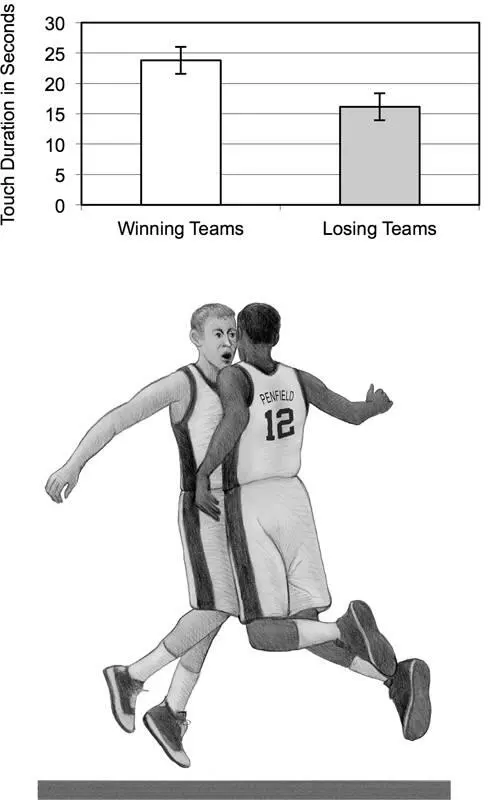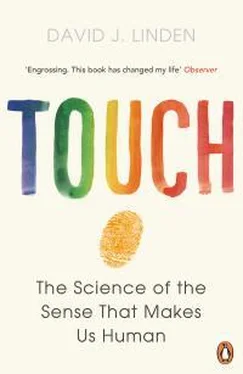Subsequent experiments and observations outside the laboratory by Asch and many others have shown that the warm/cold dimension is the strongest component of both the first impressions of individuals (the second strongest being competent/incompetent) as well as of group stereotypes when evaluated across many countries and cultures. 3Why do we respond so naturally to the linguistic metaphor of the warm individual? It is likely that this metaphor has deep biological roots. We often use terms familiar from our sensory experiences to organize abstract psychological concepts. In both our individual lives and our human evolutionary history, the physical sensation of warmth has been associated with security, trust, and an absence of threat, mostly through the experience of a mother’s touch. 4
Asch’s model of impression formation suggests an obvious question: Does physical warmth relate to metaphorical warmth? Specifically, in adults, does the mere tactile experience of warmth on the skin activate feelings of interpersonal warmth that can transfer to our evaluation of an unknown person? To investigate this question, Lawrence Williams and John Bargh, of the University of Colorado and Yale, respectively, devised a clever experiment. Subjects were met in the lobby of the psychology building by an employee of the experimenters. This employee—who, crucially, was blind to the intent of the study—was carrying an awkward load: a cup of coffee, a clipboard, and two textbooks. During the elevator ride up to the lab on the fourth floor, she casually asked each subject to hold her coffee cup while she recorded the subject’s information on a form attached to the clipboard. She then took the coffee cup back and delivered the subject to the experimenters. In some cases the cup contained hot coffee, and in others, iced coffee. When the subjects arrived in the lab they were immediately given a personality assessment questionnaire like that used in Asch’s original 1943 study but without the warm/cold terms (e.g., person A was described as intelligent, skillful, industrious, determined, practical, and cautious). They were then asked to rate this fictional person on ten traits using the previously described method of opposites (humane/ruthless, dishonest/honest, and so on). They found that subjects who had held the hot coffee cup perceived the target person as being significantly warmer (humane, trustworthy, friendly) than those who had held the cup of iced coffee. Remarkably, the brief experience of physical warmth on the skin of the hands did indeed promote interpersonal warmth. 5
Is the influence of incidental tactile experience on our evaluation of an unknown person unique to warmth, for which we have an unusually strong positive emotional association, or does it apply more broadly to touch sensations in general? Could other skin sense experiences subconsciously influence our impressions about unrelated people and situations? Guided by rich tactile metaphors in the English language, like “weighty matters,” “the gravity of the situation,” “smooth negotiation,” and “hard bargainer,” John Bargh, now joined by Joshua Ackerman and Christopher Nocera, set out to test this broader hypothesis. 6First, they had passersby evaluate a single job candidate by reviewing a résumé affixed to either a light or a heavy clipboard (340 grams versus 2,041 grams, the latter being the weight of a typical medium-sized laptop computer). Subjects given the heavy clipboard rated the candidate as significantly better overall and as showing more interest in the position. The tactile experience of the weighty clipboard subconsciously caused the job applicant to be perceived as having significantly better performance and more serious intent. Importantly, the weighty clipboard did not influence subconscious impressions generally: For example, the candidate was not rated as more or less likely to get along with coworkers. Rather, the heavy clipboard specifically conferred gravitas. 7
Bargh’s group moved on to explore texture, influenced by metaphors like “I had a rough day.” In this study, passersby were first asked to complete a simple jigsaw puzzle, one group being given a puzzle in which the pieces were covered in sandpaper, and the other group an identical puzzle with smooth pieces. All subjects were then asked to read a passage describing an interaction in which the social valence of the situation was deliberately ambiguous. When subjects were asked to rate the quality of the interaction in the passage, the rough-texture subjects scored it as significantly more adversarial (versus friendly), more competitive (versus cooperative), and more like an argument than a discussion. The physical experience of a rough texture changed evaluations of a social interaction to make it seem more metaphorically “rough.” 8
Finally, a similar study was conducted using hard versus soft as the tactile manipulation. Here the psychologists disguised the touch experience by embedding it in the ongoing patter of a magic act. Passersby were asked to watch a magic trick and guess its secret. As a part of the show, subjects were asked to examine an object to be used in the trick, ostensibly to confirm that it had not been tampered with. Some subjects fondled a soft swatch of blanket; others, a hard block of wood. The magic act was then postponed while the subjects were asked to read the same deliberately ambiguous social interaction passage used in the rough/smooth study, with the difference being that they were told that the interaction was between an employee and a boss. When asked to evaluate the employee, subjects primed with the wood block were significantly more likely to rate him/her as rigid and strict, consistent with hardness as a metaphor for an unyielding, unemotional personality. (And, no, sadly, the subjects never actually got to see the magic trick.)
The fact that even incidental touch experience can influence our impressions of people and our social interactions can be more than a little disconcerting. How would that beautiful, intelligent woman I was chatting up at the Caffe Med in Berkeley in 1983 have reacted if she had had her hand wrapped around a hot cup of coffee instead of that cold Italian soda? And what about that weird department chairman who compulsively squeezed a hollow rubber ball while he interviewed me for an academic job? If he had been toying with a letter opener, would he have tended to regard me as sharper, or merely hard and unyielding?

While the Bargh incidental touch studies were well designed and their findings are useful and interesting, they do have serious limitations. Most important, they do not capture impressions as they occur in real-world situations. Survey-based experiments require that subconsciously formed impressions be made conscious and explicit, and the responses of the subjects must conform to the experimenter’s predetermined scales of measurement. This is an unnatural situation. In our daily lives we are continually forming ideas about people and situations but are not simultaneously making mental checklists assessing them on the basis of “humane versus ruthless” or “discussion versus argument.” That’s why it’s important to investigate the social roles of touch in everyday contexts.

Figure 1.2Interpersonal touch predicts increased performance in the NBA. Top: Bar graph shows total celebratory touch duration scored in a single early season game for winning and losing teams in the five games that followed during the 2008–9 NBA season. From M. W. Kraus, C. Huang, and D. Keltner, “Tactile communication, cooperation and performance: an ethological study of the NBA,” Emotion 10 (2010): 745–49. Published by the American Psychological Association; reprinted with permission. Bottom: Basketball players engaging in an airborne chest bump.
Читать дальше














